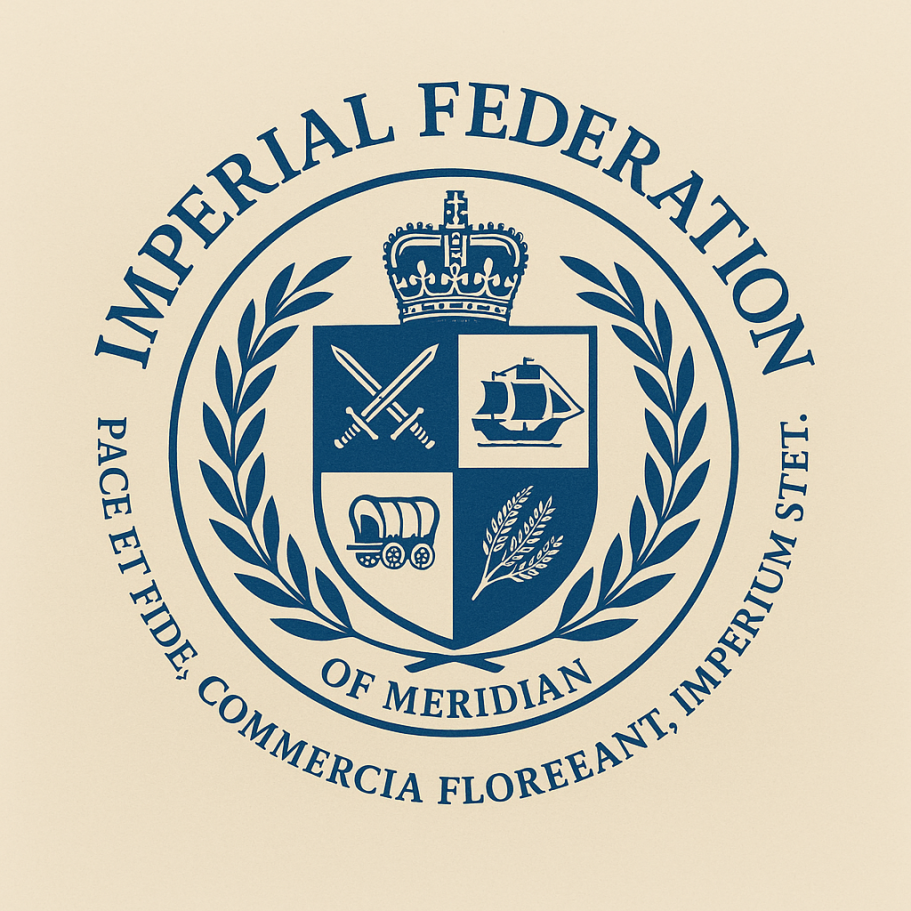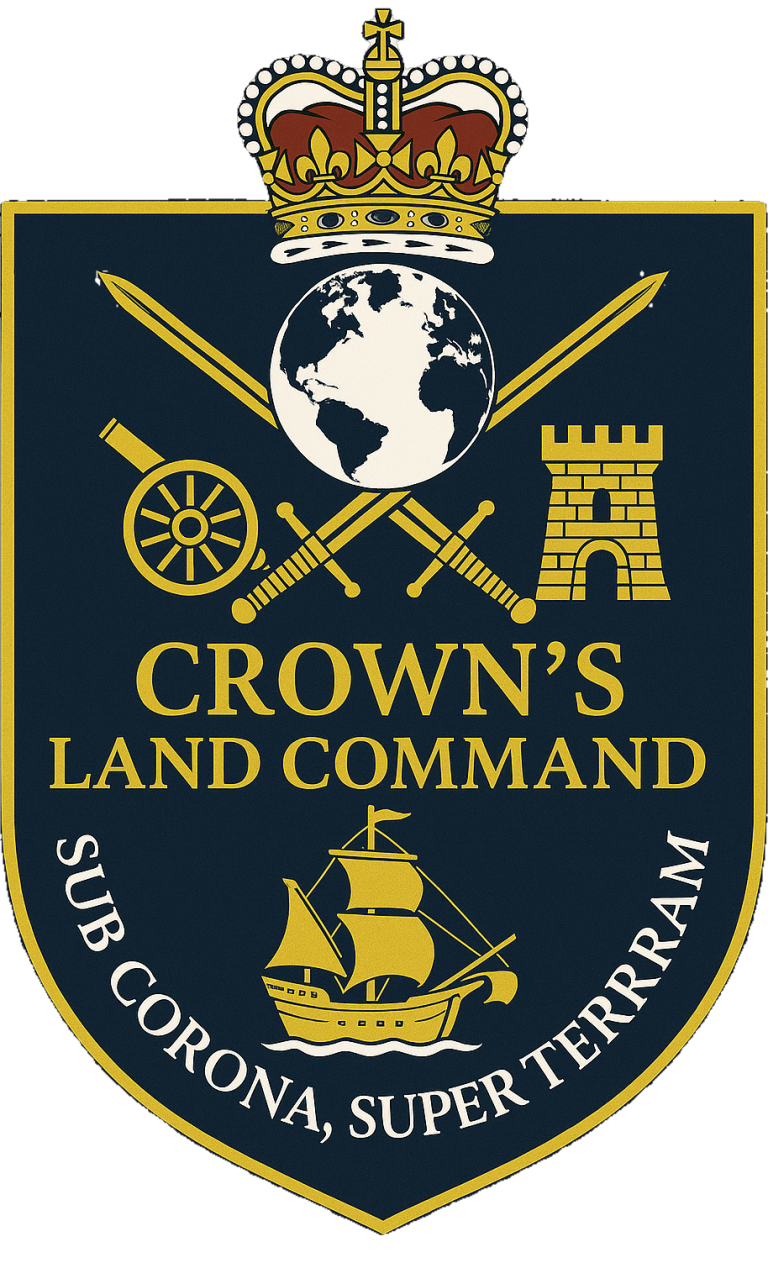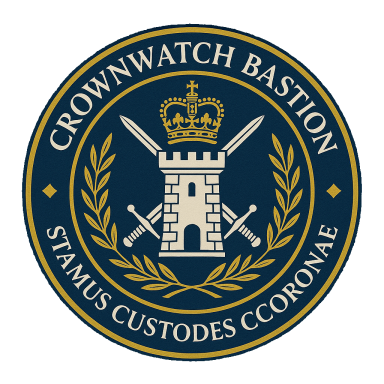Tagline
The Defence Forces of the Imperial Federation of Meridian
Lorem ipsum dolor sit amet, consectetur adipiscing elit. Nulla euismod condimentum felis vitae efficitur. Sed vel dictum quam, at blandit leo. Lorem ipsum dolor sit amet.
Imperial Oceanic Command
Lorem ipsum dolor sit amet, consectetur adipiscing elit. Nulla euismod condimentum felis vitae efficitur. Sed vel dictum quam, at blandit leo.
Crown's Land Command
Lorem ipsum dolor sit amet, consectetur adipiscing elit. Nulla euismod condimentum felis vitae efficitur. Sed vel dictum quam, at blandit leo.
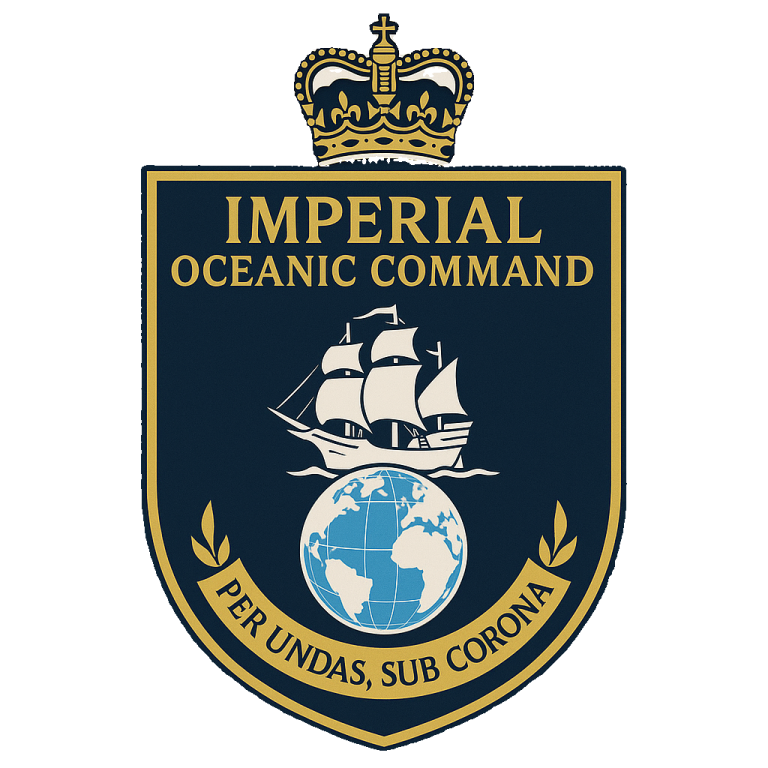
Imperial Oceanic Command
Imperial Flag Fleets

The Emperor's Trident
The most decorated and symbolic of all fleets; leads all major naval reviews and imperial war efforts

The Imperial Vanguard
Fast-response and first-strike fleet for emergent threats and border operations

Fleet of the Concordian Standard
Serves as ceremonial envoy fleet; conducts naval parades and supports high diplomacy

The Gilded Armada
Escort and protection of treasure convoys, high-value imperial commerce, and diplomatic embassies

The Obsidian Tide
Operates in secrecy and silence, executing covert missions and reconnaissance under classified orders

The Imperial Commerce Fleet
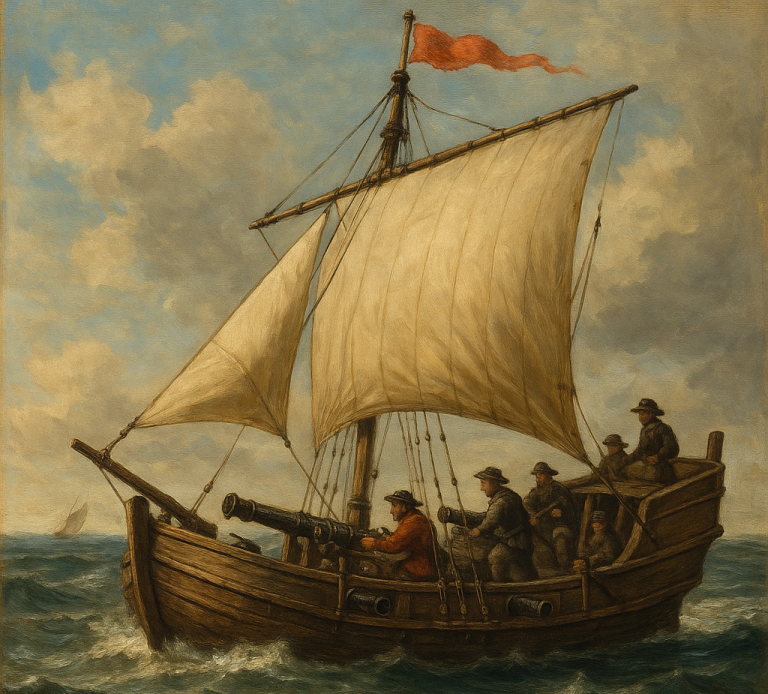
Severant-Class (Gunboat)
Fast attack and localised patrol duties
The Severant-class gunboat is the backbone of the Empire’s light naval forces—compact, durable, and highly maneuverable, built to enforce Imperial law along the coastlines, river deltas, and narrow channels of the Federation. As one of the most frequently deployed vessels in the Imperial Oceanic Command, the Severant is synonymous with swift justice and ironclad vigilance.
Unlike larger ships-of-the-line, the Severant-class prioritizes speed, shallow-draft access, and ease of maintenance, allowing it to operate in estuaries, harbors, and confined straits where larger vessels cannot follow.
General Characteristics:
- Length: 28–35 meters
- Beam: 7 meters
- Draft: Shallow draft (~2 meters), allowing access to rivers and close-to-shore operations
- Crew Complement: ~18–25 sailors and marines
- Construction: Reinforced hardwood keel with iron-ribbed hull plating; gunwales protected by angled cannon shielding
Armament:
- 4–6 Medium Cannons on pivot mounts (2 fore, 2 midship, 2 aft)
- 1 Rotating Carronade or Culverin at the bow
- 2 Swivel Guns at the quarterdeck or crow's nest platform for repelling boarders
- Optional Firepot Launcher or Ballista, depending on mission profile
Fleet Role:
- Escorts large warships in shoal-heavy regions
- Patrols provincial harbours, rivers, and sea forts
- Conducts sabotage raids and blockade running
- Deployed in flotillas for anti-piracy and border enforcement
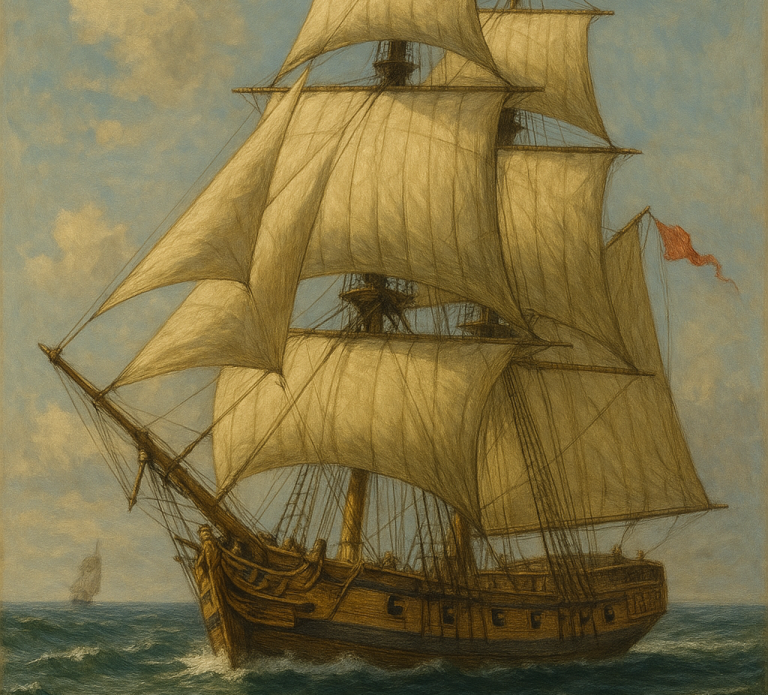
Cataran-Class (Brig)
Escort, skirmish, coastal interdiction
The Cataran-class is a two-masted, square-rigged warship designed to fill the vital space between gunboats and full-sized frigates in the Imperial Oceanic Command. Though technically classified as a brig, Catarans are often referred to as the “knights of the sea” due to their agility, resilience, and proud silhouette.
Where Severant-class gunboats dart and strike, Catarans hold the line, serve as picket sentinels, or outmaneuver bulkier vessels in shoal-heavy waters. Their reinforced prow and balanced keel make them stable in rough seas, while their rigging allows for both surprising speed and tight turning radii.
General Characteristics:
- Length: 28–35 meters
- Beam: 7 meters
- Draft: Shallow draft (~2 meters), allowing access to rivers and close-to-shore operations
- Crew Complement: ~18–25 sailors and marines
- Construction: Reinforced hardwood keel with iron-ribbed hull plating; gunwales protected by angled cannon shielding
Armament:
- 4–6 Medium Cannons on pivot mounts (2 fore, 2 midship, 2 aft)
- 1 Rotating Carronade or Culverin at the bow
- 2 Swivel Guns at the quarterdeck or crow's nest platform for repelling boarders
- Optional Firepot Launcher or Ballista, depending on mission profile
Fleet Role:
- Escorts large warships in shoal-heavy regions
- Patrols provincial harbours, rivers, and sea forts
- Conducts sabotage raids and blockade running
- Deployed in flotillas for anti-piracy and border enforcement
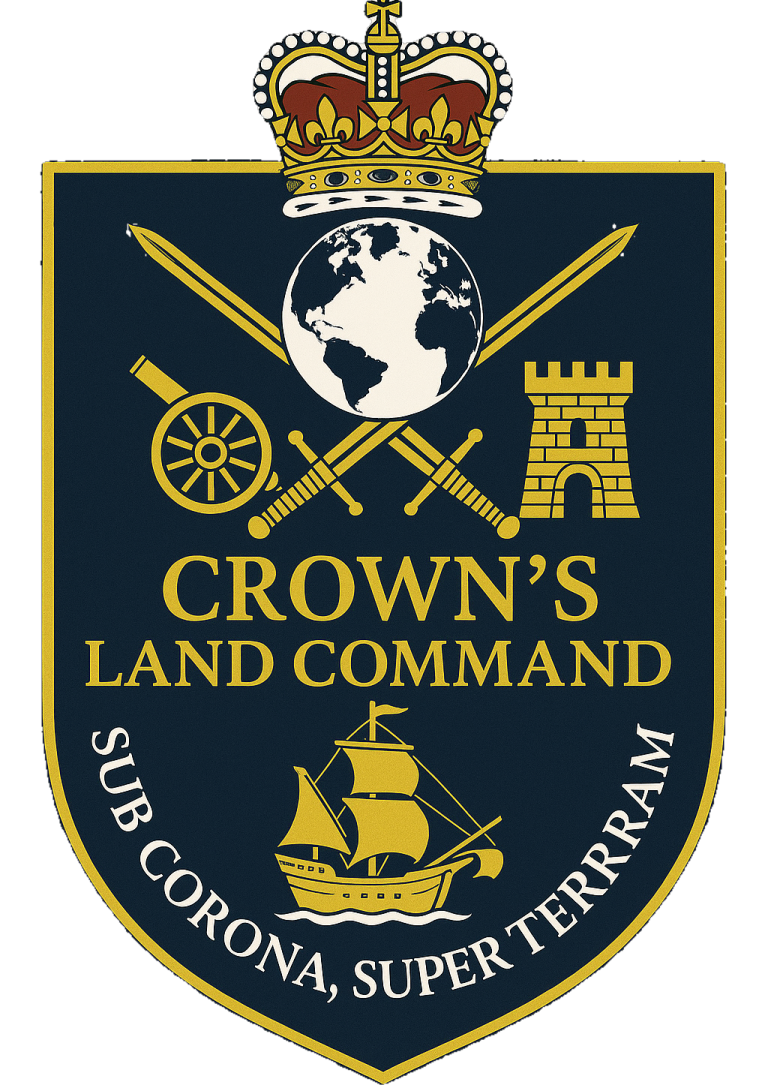
Imperial Guard Regiment
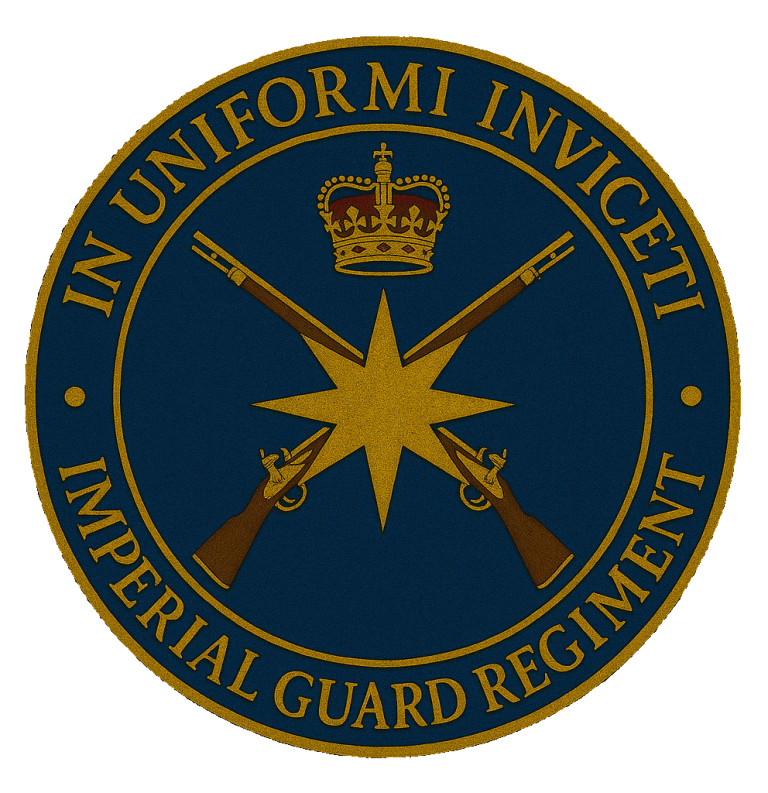
The Imperial Guard Regiment serves as the ceremonial military honor guard of the Imperial Federation of Meridian, stationed within the capital of Concordis. Though structured as a formal regiment under federal charter, it functions independently of the Crown’s Land Command and exists solely to safeguard the civic dignity and continuity of the Federation’s institutions.
Its sacred duties include the protection of the Hall of Concord, the Dome of Meridian, and all federal ministries within the Civic Core. The regiment oversees ceremonial drill formations, state oaths, funerary honors, and constitutional processions. Though not deployed for combat, its soldiers are trained in precision warfare doctrine and civil defense, and may stand as last-line protectors of the federal seat in times of grave unrest.
The regiment’s presence affirms that the law is watched by those who would not let it falter—not in chaos, nor in ceremony.
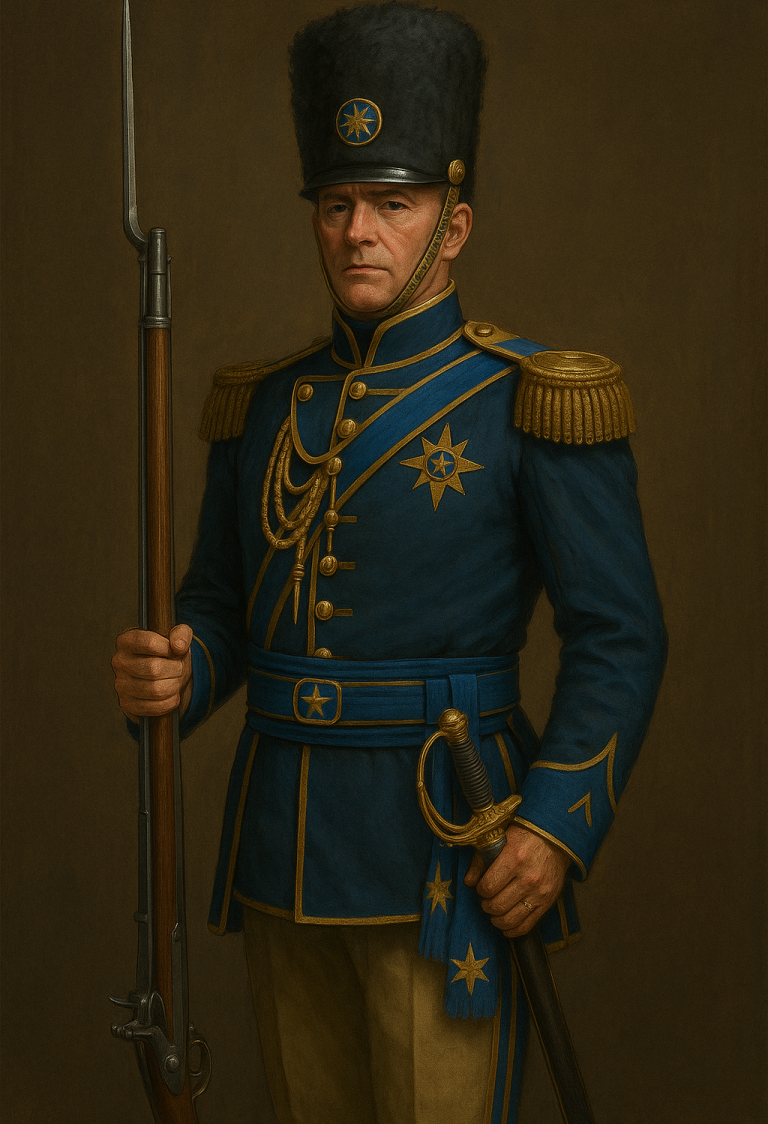
Imperial Guard Officer

Imperial Guard Private
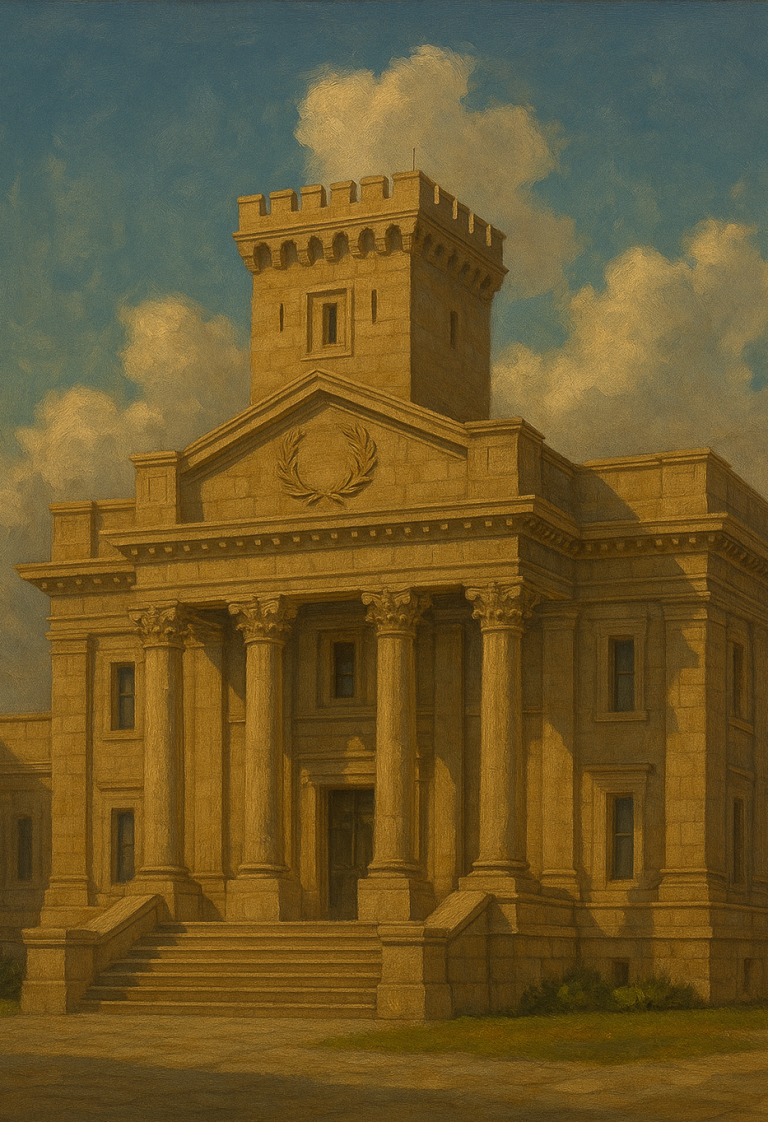
The Laurel Bastion
The Imperial Guard Regiment was founded in the final decade of the Era of Chains, during the height of the Meridian Rebellion, as the personal guard of Adrienne Valeira—High Monarch of Virellia and future Emperor Auremax I Aurelion. Then known as the Laurel Guard, the regiment was composed of hand-selected veterans, doctrine loyalists, and rebel captains entrusted with the protection of Concordant emissaries, rebel councils, and the surviving fragments of the old Republic.
Following the victory of the rebellion and the ratification of the Crown Compact in Year 0 of the Concordant Era, the Laurel Guard was formalized into the Imperial Guard Regiment, not as a personal retinue of the Emperor, but as a civic protector of the Federation’s newly established constitutional institutions. The regiment was stationed in the Laurel Bastion, a purpose-built ceremonial garrison overlooking the Hall of Concord.
The Guard is tasked with defending the physical and symbolic heart of the Federation—the Grand Assembly, Dome of Meridian, and federal ministries—through ceremonial and defensive presence. Though not deployed in war, its soldiers are trained to serve as a last bastion of order should the capital come under siege.
Today, the Imperial Guard Regiment stands as the Federation’s ceremonial honor guard: the oldest regiment in continuous service, clad in deep crimson and gold, armed with polished muskets and stoic resolve. Their motto, “In Uniform, Unyielding,” echoes the defiance of those who stood guard before there was law to protect.
Rank Distinctions
GUARDSMEN RANKS
Initiate Guardsman – (Recruit)
Recruits undergoing doctrine, uniform, and ceremonial weapons training. Assigned to Laurel Yard or drill stations under Drill Lieutenants and Corporals. May observe formal ceremonies but may not participate in public rituals until certified. No braid, grey collar trim, wears a plain musket with wooden fittings, assigned to training companies only
Guardsman – (Core Troop)
Fully trained ceremonial soldier. Carries out standard post duty, parades, funeral honours, and national guard formations. Participates in drills and oath processions and is expected to recite passage doctrine. Standard uniform: single white braid, blue facing on cuffs, polished brass belt buckle, dark blue plume
First Guardsman – (Veteran Guardsman)
Senior troop rank; models ideal formation, posture, and bearing. May lead small static details (e.g., cathedral watch posts, archive sentry shifts). Often serves as mentor to Initiate Guardsmen and represents the regiment at civic events. No braid, grey collar trim, wears a plain musket with wooden fittings, assigned to training companies only
OFFICER CORPS
Drill Lieutenant – (Training Officer)
Responsible for training all recruits and Initiate Guardsmen. Conducts daily and seasonal drill formations, formation tests, and uniform inspections. Oversees firearm salutes, honorary volleys, and parade musket maintenance. Wears a black drill belt over the sash, polished white gloves with silver-piped gauntlets, whistle chain over chest
Banner Ensign – (Ceremonial Officer)
Leads procession units during Concordant ceremonies, military parades, and tribunal openings. Ensures the correct display of provincial and federal standards during events. Escorts the Eternal Crown regalia during transitions of power. Carries ceremonial banner harness, wears a deep blue banner backcloth with the Eternal Crown crest, white waist sash with silver tassels
Laurel Lieutenant – (Unit Commander)
Commands a company (typically 30–50 guards). Directs guard rotations in assigned sectors (e.g., Ministry entrances, Concord stairs). Instructs ceremonial drill, musket precision, and uniform regulation enforcement. Silver-edged cuffs, dual shoulder braids, one vertical silver stripe on each sleeve, eagle-insignia gorget
NON-COMMISSIONED OFFICERS (NCOs)
Firelock Corporal – (Armory Custodian)
Supervises weapon readiness, musket rituals, and salute formation drills. Manages the armoury and maintains record of ceremonial cartridges and drill salvos. Inspects firearms for accuracy and uniformity before each national event. Muskets bear custom-etched barrels, wears a gunmetal gorget and polished cartridge box with laurel crest
Standard Corporal – (Junior NCO)
Second-in-command of a small ceremonial unit (6–10 guards). Prepares watch orders, helps arrange banners, and relays officer commands. Acts as liaison between the Drill Lieutenant and Guardsmen. One silver braid on left epaulet, light blue plume on shako or tricorn, silver buckle on crossbelt
Sergeant of Formation – (Senior NCO)
Leads multiple squads across overlapping shifts. Manages crowd control, vigil shifts, and unexpected ceremonial deviations. Reports misconduct, ensures internal discipline, and upholds drill conduct standards. White chevrons on cuffs, blue shoulder knot on right arm, optional pistol holster (ceremonial)
SPECIAL HONORARY TITLES
Laurel Archivist
Maintains the regiment’s record books, doctrinal scrolls, and lineage rolls. Not a combatant rank; typically, a former officer or scholar assigned to the bastion's inner archives Wears half-length ceremonial coat with scrollwork embroidery, carries doctrine satchel and silver ink stylus Watcher of the Flame
Lights the ceremonial Ashfall Eve torch with a flame preserved from the ruins of Concordium. Selected by vote of senior officers and sergeants. Honors a guardsman of exceptional composure, doctrine knowledge, and moral bearing. Carries the Ashfall Torch, wears a fire-red silk lining beneath cape, ceremonial cinderstone medallion
Crown Sentinel
Rotating elite chosen to stand at the Eternal Crown beneath the Dome of Meridian. Required to hold position in silence for an entire cycle (traditionally 8 days). Considered a rite of passage before promotion to First Guardsman or Officer Track. Polished ivory scabbard, gold Star of Meridian embossed on gloves, stands in full silence with helmet crest removed
Unit Sizes
Drill Squad (15–20 Initiate Guardsmen)
Training unit under a Drill Lieutenant
Rotates through Laurel Yard, the Chamber of Silence, and public drill formations
Not deployed to ceremonial events until cleared by inspection and doctrine test
Colour Guard / Banner Team (5–7 soldiers)
Ceremonial detachment assigned to carry banners, relics, and escort regalia
Includes at least one Banner Ensign, flanked by standard bearers and drummers
Section (10–12 soldiers)
Tactical unit for ceremonial formations, static post duty, and salute details
Led by a First Guardsman or Sergeant of FormationMay be permanently assigned to guard specific relics, archives, or gates
Platoon (50–60 soldiers)
Core operational unit within each company
Led by a Standard Corporal or Drill Lieutenant
Assigned to sub-sectors (e.g., north wing of the Hall, main forum stairs, entrance arch)
Company (200–250 soldiers)
Led by a Laurel Lieutenant or Captain of the Hall
Each company is permanently stationed at a core federal site:
- Hall of Concord Company (Grand Assembly & Dome of Meridian)
- Ministries Company (Federal ministry circuit)
- Presidential Procession Company (Escort & public ceremonial guards)
- Tribunal Company (High Court & Judicial guard)
- Reserve Drill Company (Training & support)
Regiment (1,000–1,200 personnel)
The full formation of the Imperial Guard Regiment
Commanded by the Regiment-Marshal of the Laurel Bastion
Headquarters: The Laurel Bastion, Concordis
Divided into 4–5 companies, each tied to a key civic or ceremonial zone
Meridian Provost Guards

The Meridian Provost Guard serves as the military police branch of the Crown’s Land Command within the Imperial Federation of Meridian. Its sole duty is to enforce military discipline, oversee internal security within the armed forces, manage military detainment, and execute martial justice across the Federation’s regiments, garrisons, and war theatres.
Ordo Per Honorem. Iustia Sine Metu - Order Through Honor. Justice Without Fear.
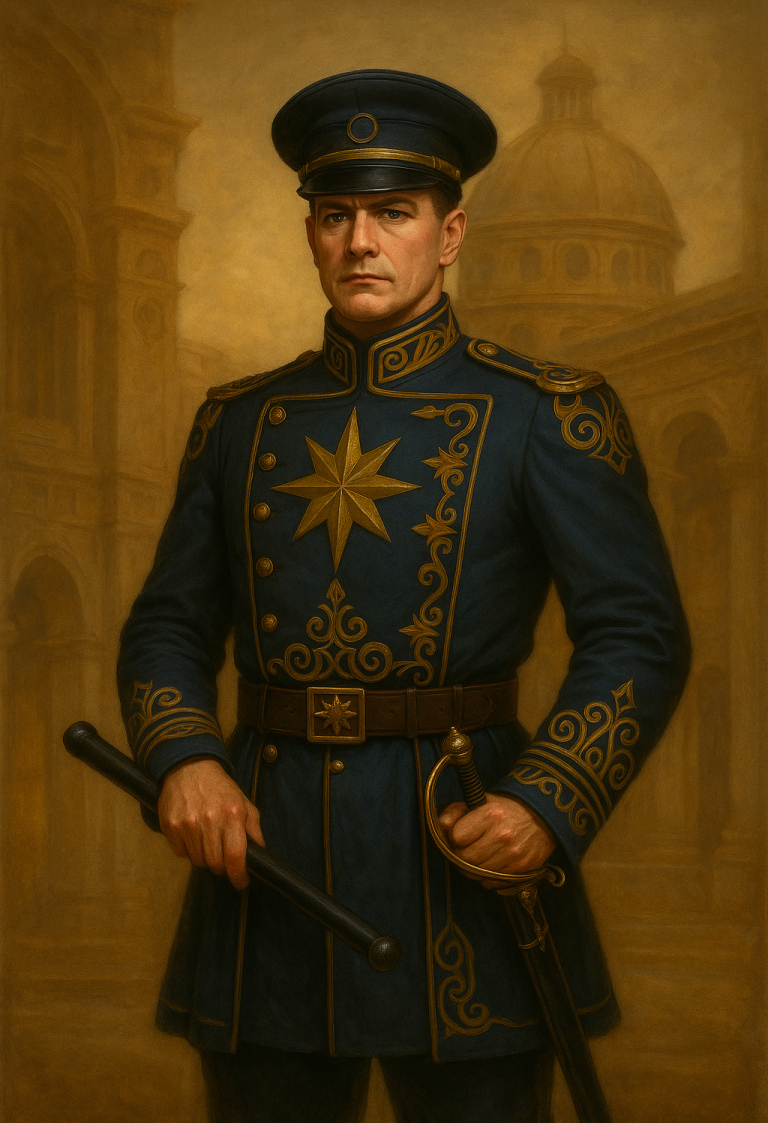
Meridian Provost Guard Officer

Meridian Provost Guard Constable

The Chainhold
The Meridian Provost Guard was founded in the 132nd year of the Concordant Era,
following the disastrous breach at Fort Caelestis, where undisciplined internal disorder led
to the near-collapse of an entire Crown’s Land Command regiment. Recognizing the need
for an elite internal force to uphold military law, discipline, and battlefield integrity, the
Grand Assembly authorized the formation of a specialized corps under the Ministry of
Internal Affairs.
The Guard was first deployed during the suppression of the Borderland Rebellions, earning
a reputation for unwavering discipline, fearlessness, and incorruptible resolve. Known by
the moniker "The Chain of Law," its officers were granted authority to arrest even high-
ranking field commanders if found derelict in duty.
Today, the Meridian Provost Guard remains the sole military police body of the Federation,
revered and feared for their role in preserving order within the ranks of war. Their
presence at tribunals, drills, and musters signals both stability and the strict expectation of
martial conduct.
Rank Distinctions
Enlisted Ranks
- Constable: Entry-level military police. Conducts foot patrols in garrisons, camps, and command zones. Guards stockades, handles minor infractions (e.g., curfew violations, disorder). Escorts low-risk detainees. Plain navy-blue uniform, brown leather belt.
- Senior Constable: Leads small patrol units or checkpoints. Responsible for detainment security and internal watch during active deployments. Assists in preparing minor tribunal documentation and duty reports. Single silver sleeve chevron, brass cuff piping, small Star of Meridian pin on collar.
- Corporal of the Watch: Supervises squad-sized provost details (6–8 personnel). Assigns guard posts, oversees facility access points (armouries, gates). Acts as shift commander in absence of a sergeant. Two silver chevrons, red sash, brass belt buckle with Star of Meridian.
- Sergeant of the Guard: Commands sections (16–24 personnel). Enforces discipline at the regimental level. Oversees daily operations of detention blocks and enforces camp law under officer orders. Conducts roll calls and incident reviews. Three gold-outlined chevrons, gold-trimmed cuffs, one pip on shoulder tabs.
- Master-Sergeant Provost: Senior-most non-commissioned officer at a garrison or forward base. Advises junior officers on disciplinary trends. Oversees arrest procedures for officers and higher command. Trusted with execution of sensitive operations such as high-profile prisoner transfers. Three chevrons with laurel, gold-striped epaulettes, blue armband with gold star.
Officer Ranks
- Ensign Provost: Junior officer overseeing small platoons or assigned to mobile enforcement teams. Leads investigations of infractions such as insubordination, sabotage, or cowardice. Carries the authority to issue citations and temporary confinement orders. Gold collar braid, one gold pip on boards, blue sash with gold stripe.
- Lieutenant Provost: Commands full platoons or acts as adjutant to higher command. Issues arrest orders, manages evidence processing and detainment logistics. Supervises tribunal preparation and coordination between Guard and judiciary clerks. Two pips, gold-trimmed boards, double-striped sash, cuff embroidery.
- Captain of Order: Oversees a full company (~100 personnel). Manages military prisons, tribunal chambers, and key checkpoints within a region. Conducts officer discipline reviews and enforces tribunal rulings in wartime. Three pips, fringed epaulettes, star over heart, baton holster.
- Major of Justice: Regional enforcement commander overseeing multiple companies or a full battalion. Directs provost operations across military districts. Coordinates with Crown’s Land Command officers on regional order and wartime enforcement doctrine. Three pips with gold bar, braided cuffs, engraved buttons, seal medallion.
- Marshal Provost: Commands an entire provost regiment (~1,000+ personnel). Enforces discipline in entire military theaters. Oversees logistical security, POW facilities, and integrity of officer corps. Has authority to declare martial lockdowns in coordination with army command. Star with laurel, triple-fringed epaulettes, starburst cap, ceremonial sabre.
High Command
- Deputy Lord Provost: Second-in-command of the Meridian Provost Guard, stationed at The Chainhold. Issues national-level directives to Marshals Provost. Oversees tribunal protocols, officer promotions, and policy implementation. Sunburst and two pips on epaulettes, gold aiguillette, cape clasp star.
- Lord Provost-General: Supreme commander of the Meridian Provost Guard. Custodian of the Chain of Law, responsible for Guard doctrine, ethics, and wartime autonomy. Can authorize the arrest of generals, initiate high tribunals, and override regional commands during internal crises. Platinum star on chest, imperial braid, golden cloak, Chain of Law medallion.
Unit Sizes
Squad (Provost Detail)
6–8 personnel
Commanded by: Senior Constable or Corporal of the Watch
Role: Field enforcement within a company-sized formation.
Section (Provost Patrol Section)
16–24 personnel
Commanded by: Sergeant of the Guard
Role: Garrison policing and guard rotation coordination.
Platoon (Guard Platoon)
40–50 personnel
Commanded by: Master-Sergeant Provost with officer support
Role: Regiment-wide enforcement and internal security.
Battalion (Provost Command Battalion)
400–600 personnel
Commanded by: Major of Justice
Role: Multi-garrison tribunal security and POW management.
Regiment (Regional Provost Regiment)
1,000–1,200 personnel
Commanded by: Marshal Provost
Role: Enforces military law in entire war theatre.
Grand Command (Imperial Provost High Command)
Command staff and elite cadre (~100+)
Led by: Deputy Lord Provost and Lord Provost-General
Role: Strategic oversight of all military policing in the Federation.
Company (Field Provost Company)
~100–120 personnel
Commanded by: Captain of Order
Role: Regional enforcement, detainment, and investigation.

Imperial Strategic Corps
Cetero oporteat sensibus his eu. Has ex vidisse perpetua, vis partem mollis mandamus at. Ea nam legere mentitum prodesset, no quo lucilius liberavisse, te oratio debitis omittantur eos. Sea ea iusto detracto, ut scripta sapientem suavitate cum, nam deleniti perpetua intellegam an. Ei per officiis detraxit probatus, vim at graecis tincidunt.
Defence Infrastructure
Crownwatch Bastion
Stamus Custode Ccoronae - We Stand as Guardians of the Crown
Positioned on the Southern border of Concordis at the heart for the Imperial Federation of Meridian. Strategically placed on the main travel routes from the Southern Provinces, Crownwatch Bastion is a symbol of power and prestige to citizens, merchants, travellers and agitators alike.
©Copyright. All rights reserved.
We need your consent to load the translations
We use a third-party service to translate the website content that may collect data about your activity. Please review the details in the privacy policy and accept the service to view the translations.
